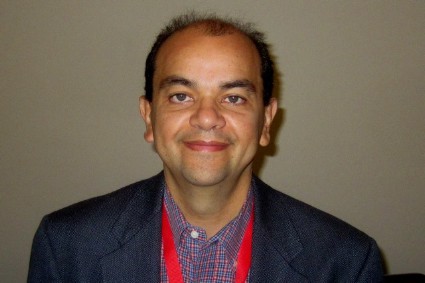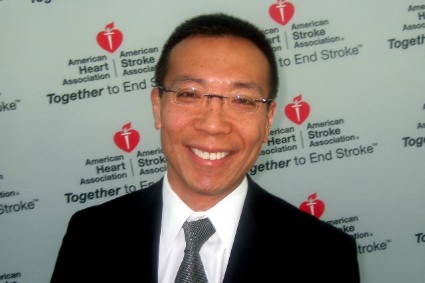User login
SAN DIEGO – Cerebral vasospasms open up, on average, 34.9% more when patients are infused with an intra-arterial cocktail of nicardipine, verapamil, and nitroglycerin, instead of the usual approach of nicardipine or verapamil alone, according to a retrospective study from the University of Texas, Houston.
Investigators there compared the cocktail to single-agent infusions in patients with vasospasms due to aneurysmal subarachnoid hemorrhages, after the offending aneurysms had been clipped or coiled.
Fifty-four patients with 116 spasmed vessels were infused with verapamil 10 mg or nicardipine 5 mg per vascular territory. Another 50 patients with 106 spasmed vessels were infused with verapamil 10 mg, nicardipine 5 mg, and nitroglycerin 200 mcg per vascular territory. The patients underwent repeat cerebral angiography at least 15 minutes after treatment.
In addition to having greater average dilation, the cocktail group had significantly greater improvement in the ratio of arterial lumen diameter before and after treatment than did the single-agent group (45.8% vs. 10.9%, respectively). The effect was independent of age.
There was a trend toward more modified Rankin Scale (mRS) scores of 0-2 in the multiple-agent group, but it was not statistically significant. Lead investigator Dr. Peng Roc Chen, a cerebrovascular neurosurgeon at the University of Texas, Houston, has launched a prospective randomized trial with his colleagues to investigate the matter further. Nine medical centers have signed up so far, and they are looking for more.
Single-agent infusion is standard practice in the United States, usually with verapamil, but it doesn’t work well, "and there’s no conclusive literature suggesting the best intra-arterial infusion regimen for vasospasm, particularly when balloon angioplasty is not feasible," Dr. Chen said at the International Stroke Conference, sponsored by the American Heart Association.
The team hoped for synergistic effects by combining commonly used intra-arterial vasodilators with different mechanisms of action, while avoiding the cardiovascular instability that comes with high-dose infusion of single agents. Verapamil and nicardipine are both calcium-channel blockers, but they work on different receptors, he said.
At discharge, 24 (44.4%) patients in the single-agent group had an mRS score of 0-2, 28 (51.9%) had an mRS score of 3-5, and 2 (3.7%) had died. At 3 months, 25 of the 34 patients not lost to follow-up (73.5%) had an mRS score of 0-2, seven (20.6%) had an mRS score of 3-5, and 2 (5.9%) had died.
In the multiagent group, 31 (62%) had an mRS score of 0-2 at discharge, 16 (32%) had an mRS score of 3-5, and 3 patients (6%) had died. At 3 months, 29 of the 36 patients not lost to follow-up (80.6%) had an mRS score of 0-2, 4 (11.1%) had an mRS score of 3-5, and 3 (8.3%) had died.
Small numbers and follow-up loss may have contributed to the lack of outcome significance. It’s also possible that subarachnoid hemorrhage drove outcomes, regardless of vasospasm treatment. In any case, multiagent infusion is now the standard approach at Dr. Chen’s medical center; the single-agent patients were historical controls, he said.
Sixteen (29.6%) patients in the single-agent arm needed additional treatment, either repeat infusions or balloon angioplasties. Twenty-two (44%) needed additional treatment in the multiple-agent group (P = .128).
Dr. Chen did not report patient demographics, but said there were no differences in post-treatment blood pressures, heart rate changes, or intracranial pressures between the two treatment groups. Patients who had balloon angioplasties before vasodilation were excluded from the study.
Verapamil and nicardipine were infused at a rate of 1 mg/min and nitroglycerin, at a rate of 100 mcg/min. In the single-agent arm, the investigators found no differences in vessel diameter change between verapamil and nicardipine.
The investigators reported having no relevant financial disclosures.

|
|
We’ve been learning that combining therapies seems to be better than giving a single agent. Whether this will translate into something we’ll be using down the line remains to be seen. We have to look at the safety of giving the three together. There’s a possibility, perhaps, that you could increase the diameter of the vessel too much, to the point where the patient will have edema, or you drop the pressure too much. Those issues may not have been picked up retrospectively.
Dr. Jose Suarez is head of the section of vascular neurology and neurocritical care at Baylor College of Medicine, Houston. He reported having no relevant financial disclosures.

|
|
We’ve been learning that combining therapies seems to be better than giving a single agent. Whether this will translate into something we’ll be using down the line remains to be seen. We have to look at the safety of giving the three together. There’s a possibility, perhaps, that you could increase the diameter of the vessel too much, to the point where the patient will have edema, or you drop the pressure too much. Those issues may not have been picked up retrospectively.
Dr. Jose Suarez is head of the section of vascular neurology and neurocritical care at Baylor College of Medicine, Houston. He reported having no relevant financial disclosures.

|
|
We’ve been learning that combining therapies seems to be better than giving a single agent. Whether this will translate into something we’ll be using down the line remains to be seen. We have to look at the safety of giving the three together. There’s a possibility, perhaps, that you could increase the diameter of the vessel too much, to the point where the patient will have edema, or you drop the pressure too much. Those issues may not have been picked up retrospectively.
Dr. Jose Suarez is head of the section of vascular neurology and neurocritical care at Baylor College of Medicine, Houston. He reported having no relevant financial disclosures.
SAN DIEGO – Cerebral vasospasms open up, on average, 34.9% more when patients are infused with an intra-arterial cocktail of nicardipine, verapamil, and nitroglycerin, instead of the usual approach of nicardipine or verapamil alone, according to a retrospective study from the University of Texas, Houston.
Investigators there compared the cocktail to single-agent infusions in patients with vasospasms due to aneurysmal subarachnoid hemorrhages, after the offending aneurysms had been clipped or coiled.
Fifty-four patients with 116 spasmed vessels were infused with verapamil 10 mg or nicardipine 5 mg per vascular territory. Another 50 patients with 106 spasmed vessels were infused with verapamil 10 mg, nicardipine 5 mg, and nitroglycerin 200 mcg per vascular territory. The patients underwent repeat cerebral angiography at least 15 minutes after treatment.
In addition to having greater average dilation, the cocktail group had significantly greater improvement in the ratio of arterial lumen diameter before and after treatment than did the single-agent group (45.8% vs. 10.9%, respectively). The effect was independent of age.
There was a trend toward more modified Rankin Scale (mRS) scores of 0-2 in the multiple-agent group, but it was not statistically significant. Lead investigator Dr. Peng Roc Chen, a cerebrovascular neurosurgeon at the University of Texas, Houston, has launched a prospective randomized trial with his colleagues to investigate the matter further. Nine medical centers have signed up so far, and they are looking for more.
Single-agent infusion is standard practice in the United States, usually with verapamil, but it doesn’t work well, "and there’s no conclusive literature suggesting the best intra-arterial infusion regimen for vasospasm, particularly when balloon angioplasty is not feasible," Dr. Chen said at the International Stroke Conference, sponsored by the American Heart Association.
The team hoped for synergistic effects by combining commonly used intra-arterial vasodilators with different mechanisms of action, while avoiding the cardiovascular instability that comes with high-dose infusion of single agents. Verapamil and nicardipine are both calcium-channel blockers, but they work on different receptors, he said.
At discharge, 24 (44.4%) patients in the single-agent group had an mRS score of 0-2, 28 (51.9%) had an mRS score of 3-5, and 2 (3.7%) had died. At 3 months, 25 of the 34 patients not lost to follow-up (73.5%) had an mRS score of 0-2, seven (20.6%) had an mRS score of 3-5, and 2 (5.9%) had died.
In the multiagent group, 31 (62%) had an mRS score of 0-2 at discharge, 16 (32%) had an mRS score of 3-5, and 3 patients (6%) had died. At 3 months, 29 of the 36 patients not lost to follow-up (80.6%) had an mRS score of 0-2, 4 (11.1%) had an mRS score of 3-5, and 3 (8.3%) had died.
Small numbers and follow-up loss may have contributed to the lack of outcome significance. It’s also possible that subarachnoid hemorrhage drove outcomes, regardless of vasospasm treatment. In any case, multiagent infusion is now the standard approach at Dr. Chen’s medical center; the single-agent patients were historical controls, he said.
Sixteen (29.6%) patients in the single-agent arm needed additional treatment, either repeat infusions or balloon angioplasties. Twenty-two (44%) needed additional treatment in the multiple-agent group (P = .128).
Dr. Chen did not report patient demographics, but said there were no differences in post-treatment blood pressures, heart rate changes, or intracranial pressures between the two treatment groups. Patients who had balloon angioplasties before vasodilation were excluded from the study.
Verapamil and nicardipine were infused at a rate of 1 mg/min and nitroglycerin, at a rate of 100 mcg/min. In the single-agent arm, the investigators found no differences in vessel diameter change between verapamil and nicardipine.
The investigators reported having no relevant financial disclosures.
SAN DIEGO – Cerebral vasospasms open up, on average, 34.9% more when patients are infused with an intra-arterial cocktail of nicardipine, verapamil, and nitroglycerin, instead of the usual approach of nicardipine or verapamil alone, according to a retrospective study from the University of Texas, Houston.
Investigators there compared the cocktail to single-agent infusions in patients with vasospasms due to aneurysmal subarachnoid hemorrhages, after the offending aneurysms had been clipped or coiled.
Fifty-four patients with 116 spasmed vessels were infused with verapamil 10 mg or nicardipine 5 mg per vascular territory. Another 50 patients with 106 spasmed vessels were infused with verapamil 10 mg, nicardipine 5 mg, and nitroglycerin 200 mcg per vascular territory. The patients underwent repeat cerebral angiography at least 15 minutes after treatment.
In addition to having greater average dilation, the cocktail group had significantly greater improvement in the ratio of arterial lumen diameter before and after treatment than did the single-agent group (45.8% vs. 10.9%, respectively). The effect was independent of age.
There was a trend toward more modified Rankin Scale (mRS) scores of 0-2 in the multiple-agent group, but it was not statistically significant. Lead investigator Dr. Peng Roc Chen, a cerebrovascular neurosurgeon at the University of Texas, Houston, has launched a prospective randomized trial with his colleagues to investigate the matter further. Nine medical centers have signed up so far, and they are looking for more.
Single-agent infusion is standard practice in the United States, usually with verapamil, but it doesn’t work well, "and there’s no conclusive literature suggesting the best intra-arterial infusion regimen for vasospasm, particularly when balloon angioplasty is not feasible," Dr. Chen said at the International Stroke Conference, sponsored by the American Heart Association.
The team hoped for synergistic effects by combining commonly used intra-arterial vasodilators with different mechanisms of action, while avoiding the cardiovascular instability that comes with high-dose infusion of single agents. Verapamil and nicardipine are both calcium-channel blockers, but they work on different receptors, he said.
At discharge, 24 (44.4%) patients in the single-agent group had an mRS score of 0-2, 28 (51.9%) had an mRS score of 3-5, and 2 (3.7%) had died. At 3 months, 25 of the 34 patients not lost to follow-up (73.5%) had an mRS score of 0-2, seven (20.6%) had an mRS score of 3-5, and 2 (5.9%) had died.
In the multiagent group, 31 (62%) had an mRS score of 0-2 at discharge, 16 (32%) had an mRS score of 3-5, and 3 patients (6%) had died. At 3 months, 29 of the 36 patients not lost to follow-up (80.6%) had an mRS score of 0-2, 4 (11.1%) had an mRS score of 3-5, and 3 (8.3%) had died.
Small numbers and follow-up loss may have contributed to the lack of outcome significance. It’s also possible that subarachnoid hemorrhage drove outcomes, regardless of vasospasm treatment. In any case, multiagent infusion is now the standard approach at Dr. Chen’s medical center; the single-agent patients were historical controls, he said.
Sixteen (29.6%) patients in the single-agent arm needed additional treatment, either repeat infusions or balloon angioplasties. Twenty-two (44%) needed additional treatment in the multiple-agent group (P = .128).
Dr. Chen did not report patient demographics, but said there were no differences in post-treatment blood pressures, heart rate changes, or intracranial pressures between the two treatment groups. Patients who had balloon angioplasties before vasodilation were excluded from the study.
Verapamil and nicardipine were infused at a rate of 1 mg/min and nitroglycerin, at a rate of 100 mcg/min. In the single-agent arm, the investigators found no differences in vessel diameter change between verapamil and nicardipine.
The investigators reported having no relevant financial disclosures.
AT THE INTERNATIONAL STROKE CONFERENCE
Major finding: Patients who received nicardipine, verapamil, and nitroglycerin had significantly greater improvement in the ratio of arterial lumen diameter before and after treatment than did those who received verapamil or nicardipine alone (45.8% vs. 10.9%, respectively).
Data Source: A retrospective study of 50 patients infused with an intra-arterial vasodilator cocktail and 54 infused with verapamil or nicardipine.
Disclosures: The investigators reported having no relevant financial disclosures.
.

